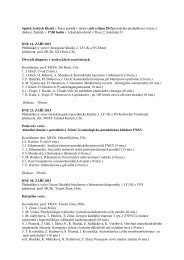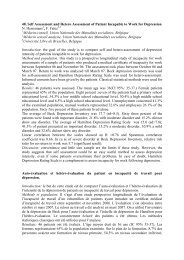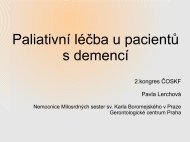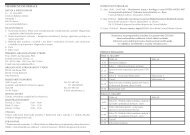ABSTRACTS â ORAL PRESENTATIONS - AMCA, spol. s r.o.
ABSTRACTS â ORAL PRESENTATIONS - AMCA, spol. s r.o.
ABSTRACTS â ORAL PRESENTATIONS - AMCA, spol. s r.o.
Create successful ePaper yourself
Turn your PDF publications into a flip-book with our unique Google optimized e-Paper software.
Acknowledgements<br />
This work was supported by the Slovak Research and Development Agency (APVV<br />
0669-10) and the VEGA Grant Agency (2/0150/11) of the Slovak Republic.<br />
References<br />
Blaise, R., C. Alapetite, P. Masdehors, H. Merle-Beral, C. Roulin, J. Delic, et al. (2002).<br />
„High levels of chromosome aberrations correlate with impaired in vitro radiationinduced<br />
apoptosis and DNA repair in human B-chronic lymphocytic leukaemia cells.“ Int<br />
J Radiat Biol 78(8): 671-679.<br />
Griaud, F., A. J. K. Williamson, S. Taylor, D. N. Potier, E. Spooncer, A. Pierce, et al. (2012).<br />
„BCR/ABL modulates protein phosphorylation associated with the etoposide-induced<br />
DNA damage response.“ Journal of Proteomics 77: 14-26.<br />
Skorski, T. (2008). „BCR/ABL, DNA damage and DNA repair: Implications for new<br />
treatment concepts.“ Leukemia & Lymphoma 49(4): 610-614.<br />
Legend to figure<br />
Fig. 1. Immunophenotype of patient with acute B-lymphoblastic leukemia, CD34 +high<br />
immunophenotype. Parameter CD45 shows gated neutrophils (Neu), monocytes (Mo),<br />
lymphocytes (Ly) and pathologic cells (Pat).<br />
P78. THE DISTRIBUTION OF PROFLAVINE DERIVATIVES IN LEUKEMIA CELLS<br />
Zuzana Ipothova 1 , Luba Hunakova 2 , Helena Paulikova 3 , Lydia Cizekova 3<br />
1<br />
Department of Chemical and Biochemical Engineering, Faculty of Chemical and Food<br />
Technology, Slovak University of Technology in Bratislava, Slovak Republic;<br />
zuzana.ipothova@gmail.com<br />
2<br />
Cancer Research Institute, Slovak Academy of Sciences, Bratislava, Slovak Republic<br />
3<br />
Department of Biochemistry and Microbiology, Faculty of Chemical and Food<br />
Technology, Slovak University of Technology in Bratislava, Slovak Republic<br />
In last two decades, new acridine derivatives have been intensively studied as novel<br />
antitumor drug candidates which are able to intercalate into DNA and interact with<br />
nuclear topoisomerase and telomerase enzymes (Cholewinski et al., 2011). Besides<br />
accumulation in the cell nucleus, the acridine derivatives showed also an atypical<br />
subcellular localization in mitochondria and lysosomes (Peixoto et al., 2009). Recently,<br />
cytotoxicity of novel acridine derivatives, 3,6-bis((1-alkyl-5-oxo-imidazolidin-2-yliden)<br />
imino)acridine hydrochlorides (AcrDIMs), has been confirmed for leukemic cell lines<br />
(Janovec et al., 2011). These derivatives with different side alkyl chain (C2 –C6) showed<br />
182 Analytical Cytometry VII








